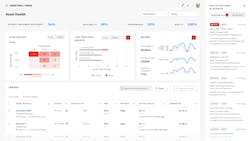The trend toward cloud-based industrial software-as-a-service (SaaS) continues with Honeywell’s enhancements of its Honeywell Forge software, including the release of the Honeywell Forge Connected Warehouse.
David Trice, chief product officer at Honeywell Connected Enterprise, says Honeywell started focusing on true SaaS, not containerized legacy solutions, in 2018. He explains Honeywell’s shift toward SaaS as a response to every manufacturing, processing, and warehouse facility being built “as a snowflake” to address specific needs and demands. The unique requirements of these facilities create complexity for running operations at the executive level and with the operations technology (OT) systems used to run the plant—which are largely still deployed as on-premises implementations. Honeywell Forge virtualizes OT systems in the cloud to lower the cost of ownership and increase speed of operations [through a focus] on personas and industry use cases. There’s a huge need to solve specific operations issues today, and that’s what we’re focusing on first.”
“We’re attacking the on-premises systems approach,” says Trice, “by building everything on an extensible model. Forge Connect talks to assets to make setpoint adjustments and prepare the data [from those assets] for delivery to the Honeywell Forge cloud.” He stresses the importance of normalizing asset data at the edge before delivery to the cloud as a key aspect of Honeywell’s Forge Connect technology.
Asset data is collected by Forge Connect via OPC UA, MQTT, APIs (application programming interfaces), and Modbus connections with plant floor devices, as well as IT interfaces to ERP systems.
In a preview of the Honeywell Forge Connected Warehouse at the Honeywell Connected Enterprise headquarters in Atlanta, Honeywell’s Asset Performance Management (APM) technology was also highlighted. The APM for Warehouse module enables maintenance teams to collaborate on equipment issues that impact performance with remediation recommendations. Operations managers and maintenance managers can use rules-based analytics and asset modeling to identify and analyze trends.
APM’s Operations Manager dashboards can be configured to highlight metrics such as order quote KPIs (key performance indicators), percent of tasks completed, and locations of issues in picking and shipping and what needs to be done to address those issues to achieve specific goals.
The Maintenance Manager dashboard in the APM for Warehouse module showcased in the preview focused on OEE (overall equipment effectiveness) and broke this metric out into its constituent parts—availability, performance, and quality. The dashboard also highlighted an asset summary status and how these factors can be sorted into a risk matrix by fault severity and asset criticality. This dashboard can also be configured to aggregate frequent faults and highlight key KPIs.
Other technology enhancements highlighted by Honeywell include:
- UniSim Design, which now provides a common simulation platform for upstream oil and gas, downstream processing, and sustainability. It contains new features for modeling Green H2, CO2 capture, transportation and storage.
- Honeywell Forge Inspection Rounds offers new features for industrial customers that allow the capture of images and videos during task execution and the creation of reusable checklists to drive standardization across an organization. Other additions include GPS-enabled monitoring of worker proximity, enhanced capabilities for gaining insights from historical data trends and improved asset identification through NFC tagging.
- New Cyber Care services supplement Honeywell’s Process Control Network (PCN) Hardening Service. After completion of the initial PCN hardening services to help industrial companies reduce their OT attack vectors, Cyber Care provides an option to purchase bi-annual onsite Cyber Care visits by Honeywell consultants for maintaining previously implemented networking hardening benefits and identifying additional PCN hardening settings for enhanced protection.
Leaders relevant to this article:




